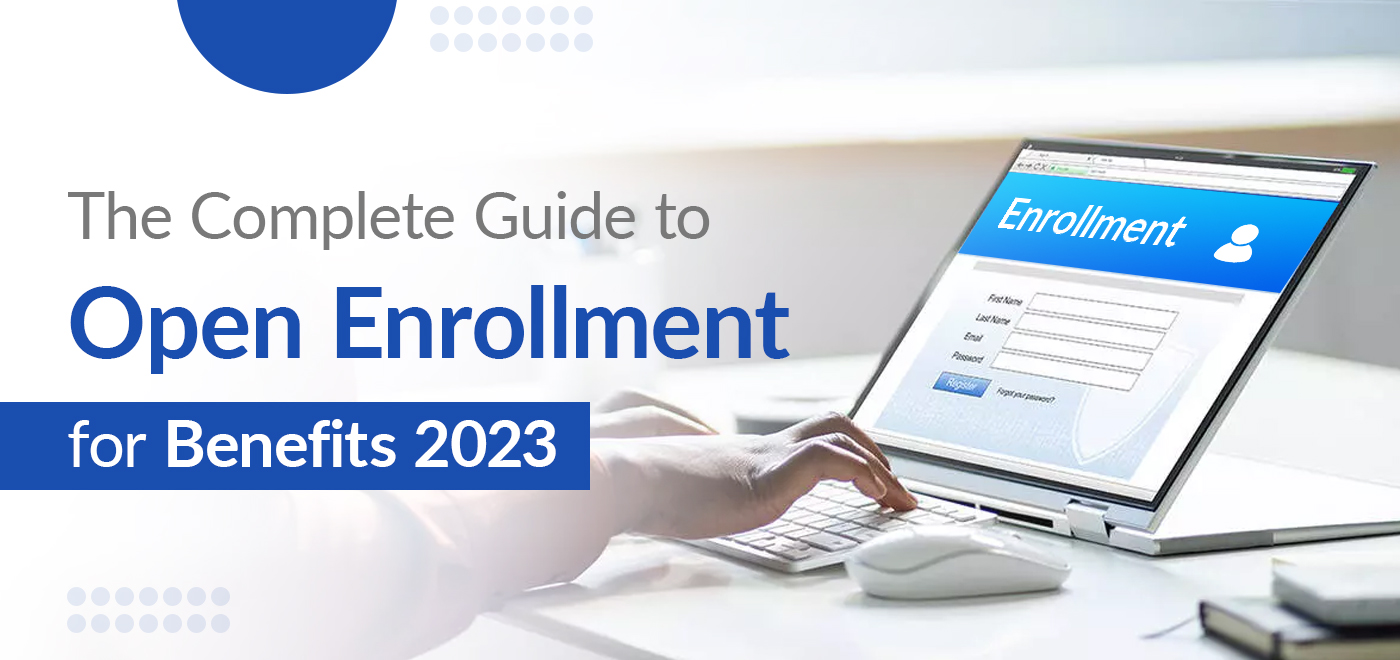Every year, open enrollment for benefits offers a set period for individuals to make desired changes to their various benefits plans. These modifications could be anything from opting for a new healthcare plan to switching your dental or vision insurance. Additionally, it’s a period for first-timers to join benefits plans or for those who have newly become eligible.
Utilizing open enrollment solutions can be a significant help, steering you through the maze of varied benefit plans. These solutions allow you to compare plans, evaluate your requirements, and eventually make well-informed choices that best safeguard you and your family. Moreover, a thorough understanding of these solutions gives you the confidence to handle the open enrollment period smoothly and effectively.
The Concept of Open Enrollment for Benefits
To put it simply, open enrollment for benefits is a specific period allowing you to enroll or alter your benefits plans. The term “benefits” primarily refers to health insurance but can also cover other benefits like dental, vision, and life insurance.
Consider open enrollment as a yearly review for your insurance plans. This is the time to scrutinize your current plans, compare them with other accessible options, and switch if required. During this phase, you have the flexibility to adopt new plans, drop unnecessary ones, or tweak existing plans based on changes in your life situation.
Key Dates for Open Enrollment 2023
Just as you pencil in important dates like birthdays and anniversaries on your calendar, you should also earmark the critical dates for open enrollment for benefits. These dates will guide you through the process, ensuring you don’t miss out on valuable chances to alter your benefits plan. So, let’s underline what you should remember for 2023.
The open enrollment period is the ‘main event’ on the benefits calendar. This period is usually scheduled toward the year-end for most employers and health insurance providers. While exact dates may differ, the open enrollment period generally stretches for a few weeks, often from early November to mid-December.
For the 2023 coverage year, you can expect similar timing. It’s important to stay informed about specific dates provided by your employer or the benefit provider. Open enrollment services often send out reminders or notifications when the period is about to begin, so keep an eye out for those!
Special Enrollment Periods
While the open enrollment period is a key time for making changes to your benefits plan, life often has a way of throwing curveballs. For significant life events that occur outside the open enrollment window, special enrollment periods (SEPs) come into play.
SEPs are triggered by certain life events such as getting married, having a baby, losing other health coverage, or moving residences. In such cases, you’re given a window—usually around 60 days before or after the event—to make changes to your benefits that specifically relate to the event.
So, why are these dates so crucial? Simply put, they determine your insurance coverage for the year to come. Missing the open enrollment for benefits period might mean sticking with a less-than-ideal benefits plan for another year. On the other hand, not taking advantage of a SEP when eligible might mean missing out on essential coverage for new life circumstances.
Various Benefit Plans
Open enrollment for benefits isn’t merely about keeping track of dates and deadlines. It’s just as much about having choices. To select the best option, you need to grasp the different benefits packages available to you thoroughly. Every plan comes with distinct features, costs, and coverage boundaries, so it’s crucial to understand the fine points before settling on one.
Generally, benefits provided during open enrollment fit into several brackets. Health insurance is often the most sought-after. This covers medical expenses like visits to the doctor, stays in the hospital, medicines, and surgical procedures. Some plans might even include preventative measures such as vaccinations and health checks.
Then, there is dental and vision insurance. Dental insurance helps cover some of the charges for dental treatments, including routine check-ups, cleanings, x-rays, and specific operations. Vision coverage typically includes eye exams, prescription glasses, or contact lenses, and in some cases, even a portion of the cost of eye surgeries
Other types of benefits include life insurance, disability coverage, and additional perks like health and wellness initiatives, employee assistance programs, and retirement schemes. The range is broad, and each comes with its own unique specifics and conditions.
Specific Details of Each Type of Benefit Plan
While this section doesn’t have room to explain every possible scheme, let’s examine three main types more closely: health, dental, and vision insurance.
Health insurance schemes differ in price and coverage. You might have come across terms like HMO, PPO, and EPO – these are different health insurance types. They differ based on elements like the network of health care providers, out-of-pocket expenses, and whether you need a referral to see a specialist.
Dental plans may be categorized into PPOs, DHMOs, or discount plans. Each type has different levels of flexibility when choosing a dentist and different cost structures. Some might cover orthodontics or cosmetic dentistry, while others won’t.
Vision plans are usually straightforward. They commonly cover routine eye exams and corrective eyewear up to a certain dollar amount. Some plans might also offer a discount on LASIK surgery or other procedures.
It’s worth noting that plans can vary greatly between providers. Therefore, always read the fine print and ask questions if something isn’t clear.
It’s crucial to review the changes during open enrollment for benefits. Perhaps a previously expensive medication is now covered, or maybe the network of healthcare providers has expanded. Changes like these can significantly impact the value you get from your plan.
How to Evaluate Your Current Benefits?
The period of open enrollment for benefits is more than simply choosing new plans. It’s equally about reviewing the current ones you have.
Why must we reevaluate our benefits? Life is fluid, always moving. Situations may shift within a year. You might welcome a newborn or deal with a lasting health issue. Such changes alter your benefit coverage needs.
Moreover, as mentioned earlier, benefit plans change too. The coverage, costs, or provider networks of your current plans may have evolved. It’s essential to reassess these alterations to ensure your plans still meet your needs effectively. So, evaluating your current benefits isn’t just an optional exercise; it’s an integral part of the process.
Steps to Assess Your Existing Benefits Package
The first step in reviewing your benefits is to gather all the details. Get your policy documents, benefits summaries, and any other necessary records. Note down the key details of your current plans, including the coverage, costs, limitations, and exclusions.
Next, reflect on your experience with these plans over the past year. Did you feel your health insurance was adequate? Did you exhaust your vision benefits before the year ended? Was the network of providers sufficient for your needs? These questions can give you a sense of what worked and what didn’t.
Finally, consider any changes in your life or health status. A new dependent or a new diagnosis can dramatically shift your requirements from your benefit plans. Ensure your evaluation accounts for these changes.
Things to Consider While Evaluating (Cost, Coverage, etc.)
While evaluating your benefits, several factors need your attention.
The cost is surely a big factor. Check your premiums, deductibles, copayments, and max out-of-pocket costs. If these were heavy, you might need a new plan.
Coverage is another crucial aspect. If you felt under-protected or over-insured last year, you might want to adjust your coverage levels. Similarly, if your network of doctors or hospitals was inadequate, consider plans with broader networks.
Also, reflect on your usage. If you don’t use certain benefits, it might be time to let them go. Similarly, if you exhausted your benefits, consider plans with more coverage.
Finally, think about your peace of mind. Benefits are not only about financial savings, but they also provide security. If a plan has been causing you stress, that’s a valid reason to think about a change.
Hence, evaluating your current benefits is a crucial step in your open enrollment journey. It’s not a task to rush through but a process that deserves your time and attention. So, as you embark on this year’s open enrollment for benefits, remember to reflect, assess, and proceed. These thoughtful steps can lead you towards benefits enrollment solutions that truly serve your needs.
Comparing New Plans and Options during Open Enrollment for Benefits
When you’ve evaluated your current benefits and recognized your needs, you’re ready to compare new plans and options. This step can be challenging, given the myriad of plans available during the open enrollment for benefits.
The process of comparing benefit plans isn’t as daunting as it seems if you break it down into manageable steps. First, list the benefits you need for the upcoming year based on your evaluation of the current benefits. Then, using your benefits enrollment company resources, identify the plans that offer these benefits.
Now, for each of these plans, take note of their key features. These include the benefits covered, the costs involved, and the provider networks. Tools like benefits summaries and plan comparison charts can help in this task.
The final step is to compare these features across various plans. Which plan offers the best coverage? Which one fits your budget? Answers to these questions will help you pick the most suitable plan for your needs.
Factors to Consider While Comparing (Premiums, Out-of-Pocket Costs, etc.)
As you compare benefit plans, several factors should guide your analysis.
Premiums are an important point. It’s the amount you pay monthly for your plan, whether you use the benefits or not. Lower premiums might seem appealing, but this usually means you’ll pay more when you do use the benefits. So, when choosing the level of your premiums, think about how often you’ll be using the benefits.
Next are the out-of-pocket costs, such as deductibles, copayments, and coinsurance. These are the costs you’ll need to cover yourself, separate from your monthly premiums. If you plan on using your benefits a lot, a plan with higher premiums but lower out-of-pocket costs might make sense.
Don’t overlook coverage, either. A plan might be cheap but may not offer the coverage you need. So, ensure the plan covers the benefits you need, and pay attention to any exclusions or limitations.
Finally, consider the network of providers. If you have preferred doctors or hospitals, ensure they’re in the plan’s network. Getting care from providers outside the network can really hit your wallet hard.
Steps to Follow for Successful Open Enrollment for Benefits
The first step in the open enrollment for benefits process involves understanding your current benefits. Consider what’s working and what needs to change based on your past experiences and anticipated future needs.
Secondly, review new plan options and changes. Open enrollment 2023 is the time to reassess different benefits plans. Note down any alterations in existing plans or new additions worth considering.
Third, weigh your choices. Scrutinize the advantages, premiums, expenses from your pocket, and service providers linked with each plan. Be mindful that the plan with the smallest premium may not always be your wallet’s best friend if you’re a regular user of services.
Finally, make your choice and enroll. Once you’ve done the groundwork, it’s time to finalize your decision and sign up for your chosen plan.
Tips for a Hassle-Free Enrollment Process
While open enrollment might seem overwhelming, the right approach can result in a relaxed, streamlined process. Here are some pointers:
- Get a head start: Postponing your benefits review to the last minute is not a wise move. Afford yourself ample time to assess your alternatives.
- Do your research: Thoroughly read all the materials from your benefits enrollment agency. Grasping the perks, terms, and conditions of each plan is crucial.
- Seek clarity: When in doubt about any part of a plan, feel free to consult with your benefits consultant or HR representative. Keep your documents handy: Have all necessary documentation ready for the enrollment process. This can include your personal details, medical history, and information about your dependents.
Life Events and Their Impact on Open Enrollment
Life changes can greatly alter our needs and priorities, including those related to our benefits plans. For example, welcoming a newborn might make you consider extending your health coverage or adding a new family member to your existing plan.
Job changes are another major life event. A new job may offer varying benefits, and understanding them is crucial. However, if you lose your job, you will likely need to find new health coverage since benefits from your previous employer usually cease once you depart.
Lastly, if you relocate, either within your state or to a different one, it’s key to verify whether your current health plan’s provider network covers your new location. If not, a plan change may be necessary.
Life Events that Qualify for Special Enrollment Periods
The good news is that these life changes, known as qualifying life events (QLEs), can grant you a Special Enrollment Period (SEP). This SEP allows you to adjust your benefits outside the traditional open enrollment period. Here are a few life events that usually qualify for SEPs:
- Marriage or Divorce: These shifts in marital status give you the chance to modify your benefits to fit your new circumstances.
- Change in Residence: Changing your home, particularly if you move across state lines, can affect how useful and valid your current plan is.
- Birth or Adoption of a Child: Welcoming a new child into your family is a QLE that enables you to update your benefits.
- Death of a Covered Family Member: This tragic event may require changes to your existing coverage.
- Change in Income: A significant change in your income might make you eligible for different health plans or subsidies.
- Change in Employment: Job transitions can significantly affect your benefits.
Resources for Assistance
The open enrollment for benefits can be a challenging time for many employees. It requires a careful analysis of various plans, comparing them based on your unique needs, and finally, making an informed decision. However, you need not walk this path alone. Several resources offer assistance and can guide you through this process.
- Human Resources (HR) Team: Don’t hesitate to get in touch with your office’s HR team for any benefits-related queries. They have all the info on the plans on offer and can help you grasp them better. Plus, they can assist you in navigating the open enrollment process, including when it begins, how to proceed, and vital dates to keep in mind.
- Worker Assistance Programs: Numerous firms have such programs which offer a host of aid services. These might include guidance and resources to tackle the stress that may arise during the open enrollment phase.
- Internet-Based Resources: The internet is a treasure trove of information on benefits and open enrollment. Sites like Healthcare.gov are packed with detailed information on health insurance plans, eligibility criteria, enrollment windows, and so much more.
- Financial Guidance: For those with complicated financial scenarios or those needing assistance with assessing the financial side of various benefits, a financial counselor could be a godsend. They can help you understand the costs and financial repercussions of different benefit choices.
- Insurance Experts: Brokers and agents specialize in insurance plans and can offer you all the help you need to make an educated decision.
What Happens if You Miss Open Enrollment?
If you miss this opportunity, generally, you can’t make changes to your benefits plan or join until the next open enrollment comes around. The lone exception is if you experience a major life event like getting married, welcoming a newborn, or losing prior health coverage.
Let’s go over some potential situations you might face:
- Health Insurance: Failing to sign up for health insurance during the open enrollment could mean you are without health coverage for the coming year. This lack of protection could expose you to hefty medical bills.
- Dental and Vision Insurance: Much like health insurance, if you skip enrolling in these benefits, you could find yourself without coverage. Consequently, you may have to shoulder the entire cost of any dental or vision care yourself.
- Flexible Spending Accounts (FSAs) and Health Savings Accounts (HSAs): Failing to renew your enrollment might mean losing the chance to put money into these accounts. This situation could impact your capacity to save on healthcare expenses.
Conclusion
So, you’ve learned about open enrollment. Remember, it’s not just a checkmark on a form. It’s vital for your health and money safety. They give you a safety net during health or money troubles.
Avoid treating open enrollment as a trifling matter. Don’t just breeze through it. View it as an opportunity to consider what you truly need. Consequently, you can pick the benefits that fit you most aptly. With careful deliberation and planning, your benefits will genuinely serve you.
Remember, open enrollment for benefits is your time to plan your future. Spend time to look at your options. Try to understand what each choice means for you.
Open enrollment may seem tough. But it’s a crucial part of your journey to safety and good health. So, are you set to grab the chance? Ready to make the most of your open enrollment this year with Toporgs?
FAQs
What is “open enrollment for benefits”?
“Open enrollment for benefits” is a yearly period when you can change your existing benefits plans. This is the time when you can select new health or retirement plans, change your present coverage, or join benefits for the first time. It’s a chance to shape your benefits package to fit your needs better.
How do I evaluate my current benefit plan?
Evaluating your current benefits plan entails scrutinizing your existing coverage and determining if it caters to your needs. Reflect on any modifications in your life over the past year. Have you experienced any significant life events like tying the knot or welcoming a newborn? Have your health necessities altered? Verify if your current plan’s cost, coverage, and provider network align with your requirements.
What factors should I consider when comparing new benefit plans?
When scrutinizing new plans, consider several factors. Evaluate the plan’s cost, including premiums, deductibles, copayments, and maximum out-of-pocket expenses. Contrast the coverage of each plan and ascertain if they incorporate the services you require. Examine the network of health providers and check if your preferred physicians are included.
How can life events affect my open enrollment?
Certain life events, like getting married, having a child, or losing health coverage, can allow you a special enrollment period. This period lets you edit your benefits outside of the normal open enrollment period.
What if I miss the open enrollment period?
Neglecting the open enrollment period can lead to substantial complications. You might not be able to alter your benefits until the subsequent open enrollment period, typically a year later. In the meantime, you might be stuck with a benefits package that doesn’t cater to your needs. If you don’t possess any benefits, missing open enrollment could leave you without crucial coverage.




